Apple iPad mini with Retina Display: Reviewed
by Anand Lal Shimpi on November 16, 2013 8:00 AM ESTThe SoC
The iPad mini with Retina Display rounds out the three platforms that use Apple’s A7 SoC. Although both the iPad Air and iPhone 5S use the A7, the mini’s implementation is closer in nature to the iPhone. The iPad mini’s SoC has always used the same package-on-package (PoP) assembly as the iPhone, with DRAM stacked on top of the SoC itself (1GB in this case). The benefit is obviously a reduction in board area, the downsides have to do with cost and thermals. That’s the first similarity between the mini’s A7 and the iPhone’s A7.
The second is one of frequencies. While the iPad Air’s A7 runs its two Cyclone CPU cores at up to 1.4GHz, the SoC in the iPad mini and the iPhone 5S runs at up to 1.3GHz. That might sound like a minor difference, but it’s far more pronounced when you look at what happens to frequency when you’re running heavy workloads.
Once again I turn to a fairly heavy CPU workload to plot performance over time. This is a multithreaded workload, slightly modified from what we used in the iPad Air review, designed to make the CPU cores consume max power. The scale is linear and the workload is the same across all devices, so what you’re effectively looking at is a graph of thermally bound CPU performance over time across all three A7 implementations:
Being the largest device (and the only device with a metal heat spreader and no DRAM stacked on top), the iPad Air obviously maintains the highest frequencies for the duration of the test. The iPhone 5S, with a significant reduction in internal volume (and a PoP SoC) reduces its CPU frequencies early on in order to keep skin temperature down and properly manage thermals. The iPad mini with Retina Display falls between the two, with its performance curve more closely following that of the iPhone 5S.
Although the mini has a similar max operating frequency to the iPhone 5S, it is a faster device thanks to it being less thermally constrained. Similarly, the iPad Air can be much faster than its clock speed would otherwise imply. If you’re wondering why Apple has been so focused on building its own SoCs and CPU architectures, this is the reason why. There’s a fixed amount of power you can dissipate in the form of heat in these mobile devices while still maintaining a good user experience. Performance per watt is the gating metric for success in mobile, and shipping high IPC/low frequency dual-core SoCs at 32/28nm is the best optimization available to a company like Apple today.
As you’d expect, our browser based CPU tests show the mini’s A7 performing in between the iPhone 5S and iPad Air. None of these tests are anywhere near as stressful as our thermal test from above, so we don’t see exaggerated differences in performance between the platforms. For most, I suspect you won’t notice a huge performance difference between the mini and Air. Those who are heavier users (e.g. audio mixing, 3D gaming, etc…), there will be a performance difference between the two iPads.
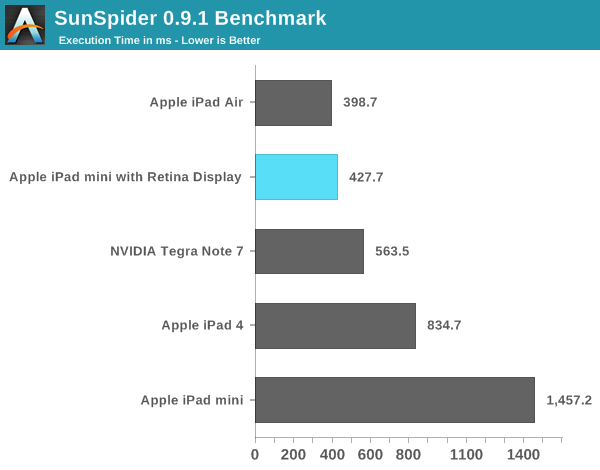

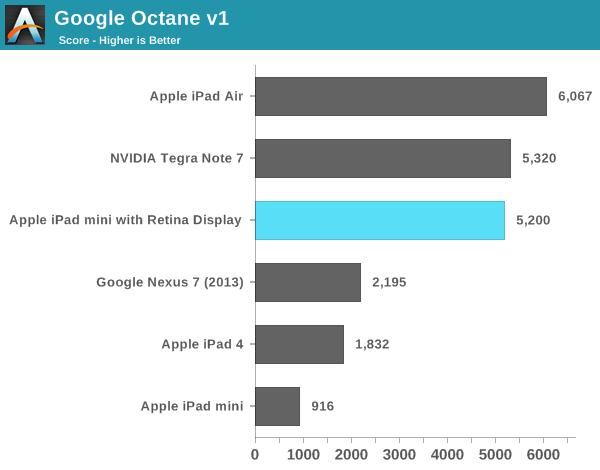
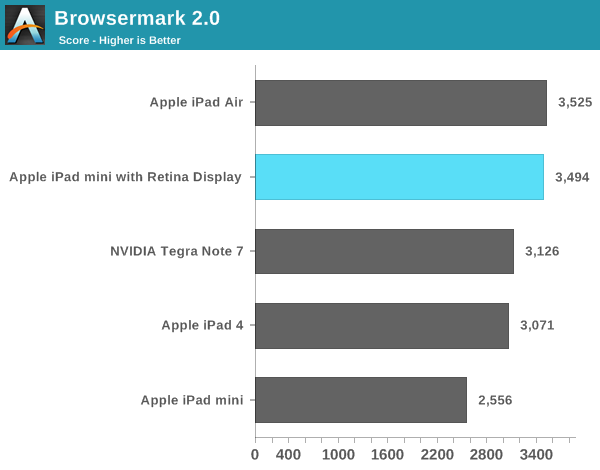
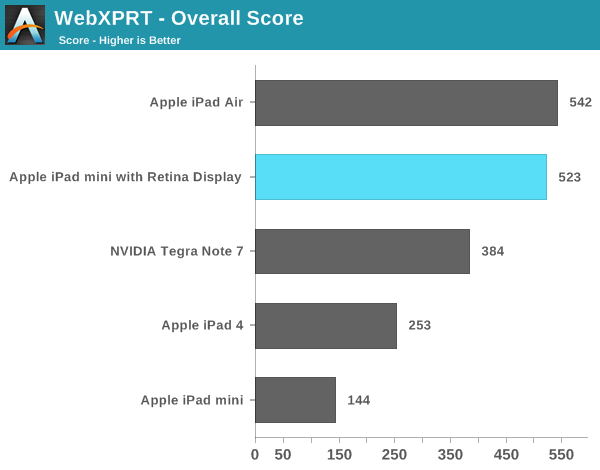
Compared to the first generation iPad mini, the new model is in a completely different performance league. Keep in mind the first mini used Apple’s A5 SoC based on an ARM Cortex A9. That’s the same single threaded performance as what’s in an iPhone 4S, and under iOS 7 it’s clearly running into some performance limits. The new mini with Retina Display however is a completely different animal. It’s fast.
Even comparing to the 4th generation iPad, the new mini is noticeably quicker.
Memory Bandwidth
Looking at the iPad mini’s memory bandwidth curve, we see it tracks very closely with that of the iPhone 5S. This is a slightly modified version of our previous bandwidth test, and you can see peak usable memory bandwidth (from the CPU’s perspective) of around 10GB/s. The ~12GB/s area right before you get out to main memory is bandwidth to the A7’s 4MB system-wide cache that sits after the shared L2 and the memory controller. This cache appears to service CPU, GPU and ISP requests at least.
GPU Performance
I believe the A7’s PowerVR G6430 GPU runs at around 450MHz. This frequency appears unchanged across all three A7 implementations. Once again, the big difference is how much thermal headroom exists in the platform which has an impact on overall performance.
Kishonti’s low level GPU performance tests back up my assertion that GPU frequency is fixed across all A7s. The iPad mini with Retina Display delivers equal performance to the iPad Air. The bigger news here is that nearly all of the GPU bound 3D tests seems to peg the mini and Air as equals. These are some pretty intense tests, but it looks like on the GPU side there’s no significant throttling when running at full tilt.
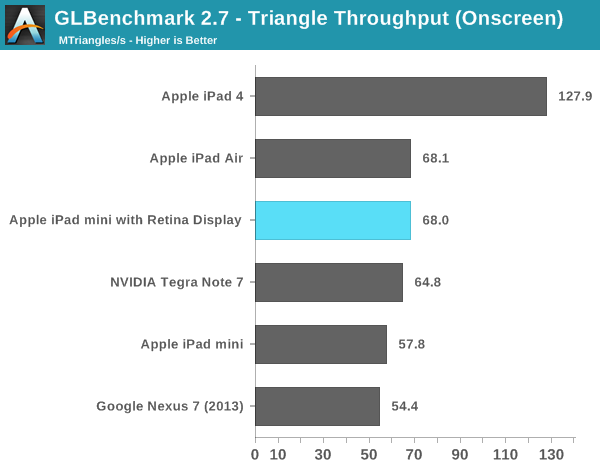

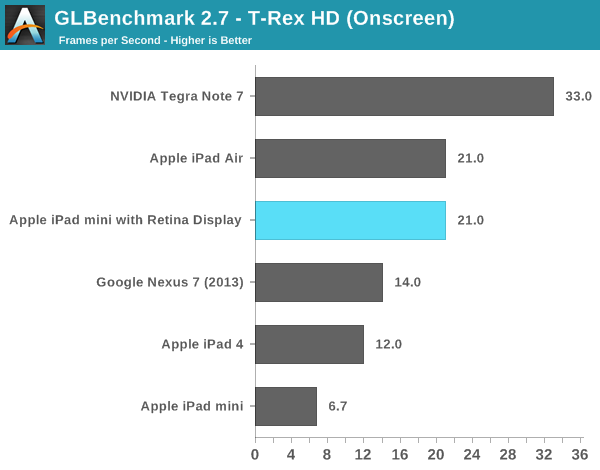

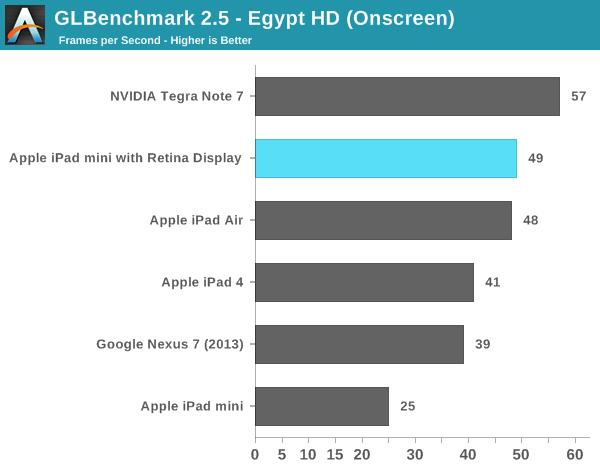
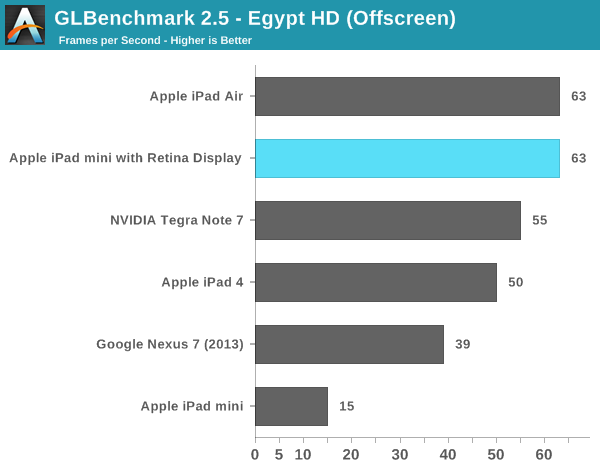
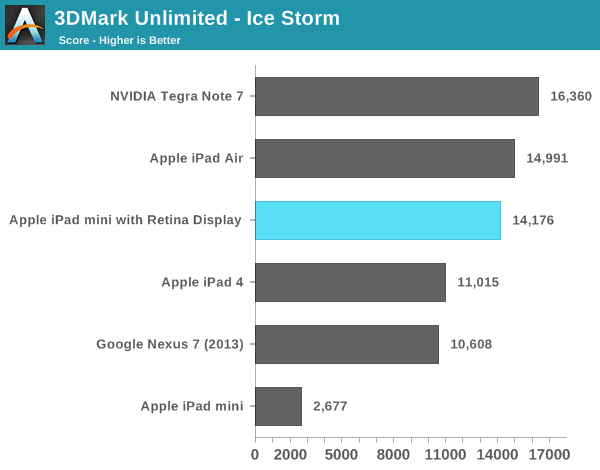
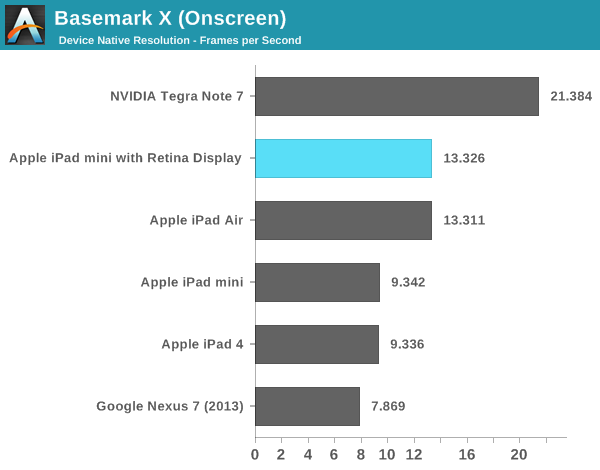
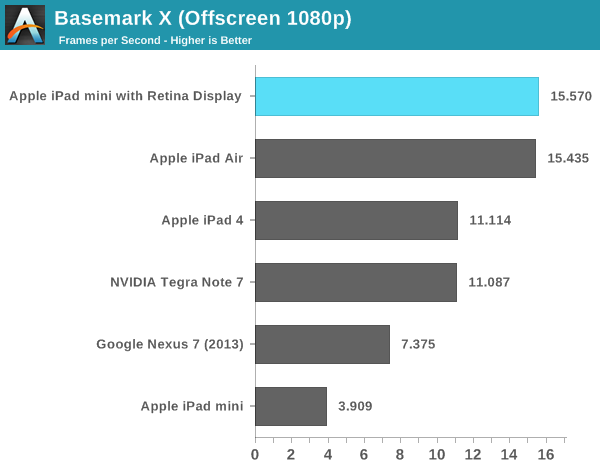
As I mentioned in our iPad Air review, despite having less peak theoretical memory bandwidth than the A5X/A6X, the A7 in the iPad mini never seems to regress in performance compared to even the iPad 4. Across the board the mini appears to be faster, more responsive and have more performance on tap than any prior iPad (big or small). The comparison to the original iPad mini is of course night and day. Even looking at lighter tests like the old GLBench Egypt HD benchmark, the iPad mini with Retina Display manages to be nearly twice as fast as the original mini - all while rendering 4x the number of pixels.


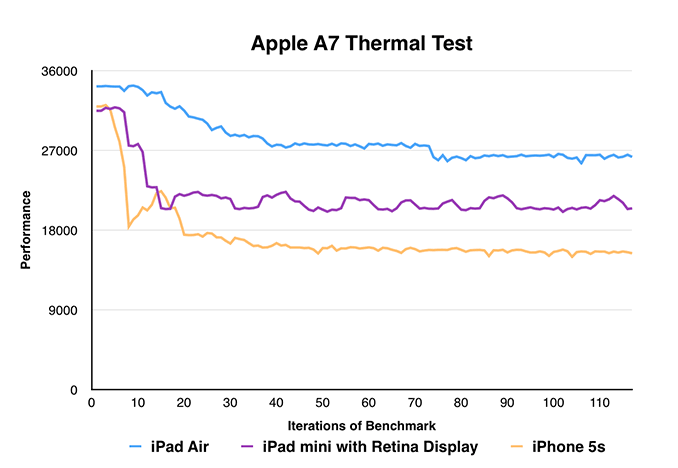
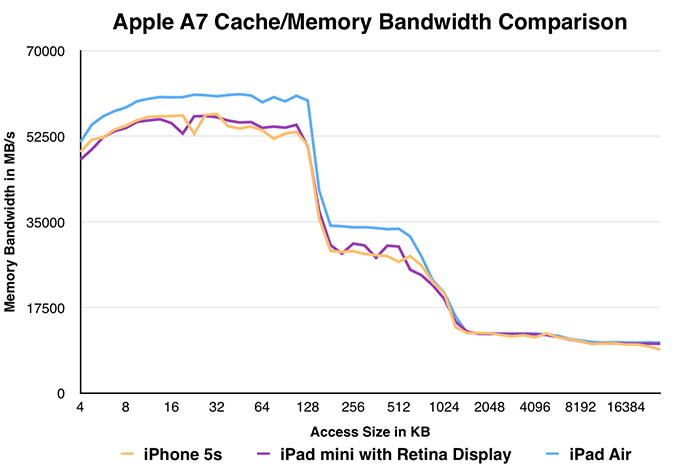








345 Comments
View All Comments
Graag - Saturday, November 16, 2013 - link
The Ars review has a good image of the compromises you make using a nexus vs. a mini for web browsing in landscape; there are some significant disadvantages to a 16:10 aspect in a 7" device in that context.lilo777 - Sunday, November 17, 2013 - link
But do they have a good image of the totally unacceptable compromises you make watching videos on iPad tablets?p_giguere1 - Sunday, November 17, 2013 - link
It's mathematically impossible for a letterboxed video to appear smaller on an iPad mini (7.9" 4:3) than on a 7" 16:9 tablet like the Nexus 7, no matter the aspect ratio.A 16:9 video for example would have a 7.251" diagonal on an iPad mini and 6.815" diagonal on a Nexus 7.
ws3 - Saturday, November 16, 2013 - link
There's a lot more to a display than PPI, isn't there?socio-statistical - Monday, November 18, 2013 - link
Ya gotta love the softball, rhetorical questions.gorskiegangsta - Saturday, November 16, 2013 - link
Can't possibly be because Apple actually makes good, solid products, can it? No. It has to be due to a wider "Apple love" conspiracy. /sHonestly, irrational-Apple-hate syndrome is just as bad as an irrational-Apple-love one, and the former is what you seem to have.
Graag - Saturday, November 16, 2013 - link
>Honestly, irrational-Apple-hate syndrome is just as bad as an irrational-Apple-love one, and the former is what you seem to have.Not, it's worse. With irrational Apple love, at least your are irrationally loving a device *that you own*.
With irrational Apple hate, you are irrationally hating a device that other people own.
IOW, while it might be somewhat annoying for someone to go on and on about how much they love their car, phone, cat, etc., it is much less obnoxious than someone going on about how much they hate your car, phone, or cat.
Puberticus - Saturday, November 16, 2013 - link
So what makes an Apple fan?I'll tell you: product reliability-at least for me.
My mac has been cranking along since 2006. Other than updating the hard drive I've never had a problem. Nor has it ever ever crashed. I have no virus software installed -yet I have never, ever had a malware problem. I honestly cannot say the same for my Windows system at work.
Your mileage may vary of course, but it's been my experience that if you buy an Apple gadget it works consistently and for a long time.
Brakken - Sunday, November 17, 2013 - link
I was really disappointed last year when I first looked at the Mini: crappy screen and slow, slow processor. But then I ended up getting one, and was so impressed! A friend got the N1 v.1 and it was a great chance to compare.WHAT A JOKE!! I've owned three non-Apple devices and the N7 was more of the same, but wrapped in more hype. Thick, plasticy and cheap. Many go for the sales point, but after being there and doing that, I've had enough!
N7 started running like it had a 386 in a few months, apps didn't scale up - just stretched out. Stock widgets were dull and let's state facts: Google vanilla has fewer functions than a skin from HTC or Samsung. No-no! You have to buy anything extra that's provided for free with a skin! Or download it from someone who wants full access to your contacts for a weather widget.
Apple love is 11 outta 10 for reasons that will always remain outside of Fandroid perceptual filters due to the price. If you wish to buy a Chevvy, that's your deal. It really isn't up to you to trash someone who decides to buy a Honda. Or a Tesla.
stevesup - Sunday, November 17, 2013 - link
10/10. Didn't happen here. That will come from Wired UK, which just gave the iPad Air 10/10. The retina Mini just might have to be an 11.